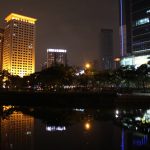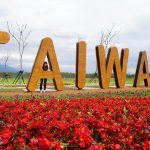長い論文ですが、現在のアジア情勢を考える重要な論点が分かり易く書かれている力作でもあります。敢えて全文をそのまま掲載させて頂きます。
「台湾の声」編集長 林建良(りんけんりょう)
December 15, 2009
U.S. Should Stay Firm on Implementation of Okinawa Force Realignment
by Bruce Klingner
Abstract: Attempts by the new Japanese government to renegotiate terms of the Guam Agreement, which would realign U.S. military forces in Japan, have seriously strained U.S.-Japan relations, harming the bilateral military alliance. The situation has not yet become a crisis, but continued mishandling could make it one. Japan needs to implement the terms of the agreement. The U.S. and Japan need to work together to reduce the current tension level and refocus on addressing regional and global security challenges.
A debate has raged between Washington and the newly elected Japanese government over implementing the Guam Agreement[1] on realigning U.S. military forces in Japan.[2] The most contentious issue is Japanese backtracking on the planned relocation of a Marine Corps air station on Okinawa. The movement of the air station from one part of Okinawa to another is no small matter. It is an integral, critical part of a broader agreement to restructure the American military presence in Japan in a manner that can sustain the military alliance deep into the new century.
President Barack Obama and Secretary of Defense Robert Gates have pressed Tokyo to fulfill its treaty commitments. The imbroglio has strained bilateral relations and established an adversarial relationship between Washington and Prime Minister Yukio Hatoyama’s administration. Although the situation has not yet become a crisis, continued Japanese ambivalence threatens to make it one.
Many U.S. experts and media advocate that the U.S. should simply accept the new Japanese government’s political rationale for altering the security accord. Some assert that the U.S. must embrace the new realities of the transformed Japanese political landscape. Doing so, however, would impair U.S. national interests by diminishing Washington’s ability to defend Japan and maintain peace and stability in Asia.
The strategic reasons for the U.S. and Japan to fulfill their security treaty commitments have been missing from most of the debate thus far. Alternative proposals have been devoid of military operational facts and have failed to acknowledge the long history of assessing and dismissing other possible options. Statements such as those asserting that the “only reason the U.S. won’t consolidate the air bases on Okinawa is because the U.S. Marines and Air Force can’t or won’t talk to each other” are simplistic, insulting to the men and women of the U.S. military, and wrong.
A 13-year review of alternative sites concluded that the existing bilateral agreement provides the best solution to fulfilling the security requirements of both the U.S. and Japan. As such, Japan should support the planned relocation of the Futenma U.S. Marine Corps Air Station to Camp Schwab on Okinawa. Further delays in resolving the issue threaten to poison negotiations on other bilateral military operational issues, such as nuclear transparency and revising the Status of Forces Agreement.
U.S. Force Realignment on Okinawa
The U.S.-Japanese Roadmap for Realignment is a comprehensive, interconnected package of force posture changes on Okinawa and the Japanese main islands. The plan is composed of 19 separate initiatives that strengthen the U.S.-Japan security arrangement based on the three pillars of “commitment to common strategic objectives; updating the roles, missions, and capabilities of both partner nations’ militaries, and a realignment of both militaries to better enable an enduring presence of U.S. military partner forces in Japan.”[3] The major provisions for U.S. force realignment on Okinawa are:
* Redeployment of U.S. Marine Corps air units from Futenma Air Station to a replacement facility to be constructed in the less populated area adjacent to Camp Schwab;
* Reduction of U.S. force levels on Okinawa by relocating 8,000 Marines and 9,000 dependents to Guam;[4]
* Japan’s provision of $6 billion of the estimated $10 billion cost to relocate to Guam;
* Consolidation of remaining U.S. Marine units in less heavily populated areas in northern Okinawa; and
* Return of several U.S. bases south of Kadena Air Base to Okinawa control.
The Okinawa realignment initiatives are interconnected. The relocation of 8,000 Marines to Guam, consolidation of Marine forces, and land returns south of Kadena depend on “tangible progress toward completion of the Futenma Replacement Facility (FRF) and Japan’s financial contributions to fund development of required facilities and infrastructure on Guam.”[5]
An Agreement 13 Years in the Making
The planned realignment of U.S. forces in Japan is the result of a lengthy series of bilateral agreements.
* 1996: Special Action Committee on Okinawa (SACO) concluded that the U.S. should return Futenma Air Station to Okinawa control contingent on Japan providing an alternative location for U.S. forces’ use.
* November 1999: The governor of Okinawa announces the decision to locate the Futenma Replacement Facility (FRF) offshore near Camp Schwab.
* July 2002: Japanese and Okinawa consultative group affirms the decision for a landfill facility offshore near Camp Schwab.
* December 2002: U.S. and Japan initiate the Defense Policy Review Initiative to strengthen the alliance and maintain deterrence while reducing the impact of U.S. forces in Japan, particularly on Okinawa.
* January 2005: The U.S. offers to move some military units from Okinawa to Guam.
* October 2005: In the “U.S.-Japan Alliance: Transformation and Realignment for the Future” document, the U.S. and Japan agree on an L-shaped facility at Camp Schwab.
* May 2006: Political joint statement details 19 interconnected realignment initiatives. Camp Schwab plan is revised to a V-shaped runway in response to Japanese environmental and political issues. The U.S. agrees to move 8,000 Marines from Okinawa to Guam with Japan paying $6 billion of the estimated $10 billion cost.
* May 2007: In the “Alliance Transformation: Advancing United States-Japan Security and Defense Cooperation” document, the U.S. and Japan reaffirmed resolve to implement the May 2006 realignment initiatives.
* February 2009: U.S. and Japan sign Guam Agreement as a legally binding executive agreement that formalizes the link between FRF and redeployment to Guam.
Japanese Election Leads to Demand to Alter Agreement
During the 2009 legislative election, the Democratic Party of Japan (DPJ) pledged to revise the U.S. force realignment agreement. Although the DPJ 2009 party platform watered down earlier demands to a more innocuous vow to “review the agreement,” Prime Minister Hatoyama continued to advocate moving the FRF off Okinawa or out of Japan entirely.
At the time of the Japanese election, the Obama Administration was concerned by some of the long-standing DPJ security recommendations, but adopted a wait-and-see attitude to allow the new DPJ government time to define its security policies. Despite U.S. hopes that the Hatoyama administration would back away from its stronger campaign rhetoric after assuming office, DPJ officials continued to advocate security policies contrary to U.S. interests.
U.S. officials’ unease increased after meeting with DPJ counterparts. As time progressed, Washington felt that its subtle messages were being ignored or rejected by the DPJ and that U.S. public silence was being interpreted as acquiescence to new Japanese security proposals. As a result, the Obama
Administration sent Secretary of Defense Robert Gates to deliver a more direct, transparent message affirming U.S. positions and delineating concerns.
Contrary to media perception that Gates’s forthright remarks reflected only a Defense Department viewpoint, his talking points were approved by an interagency process and therefore represented a consolidated U.S. government position. Gates’s message was a calculated Obama Administration risk to constrain the growing list of DPJ demands. Gates underscored the interconnected nature of the Guam Agreement, pointing out that there would be no congressional support for moving 8,000 Marines to Guam if the FRF was not constructed. Moreover, further Japanese delay on implementing the agreement risked turning next year’s local Okinawa elections into referendums on the alliance with a commensurate increase in anti-American protests on the island.
Strains in the Alliance
Bilateral strains between the U.S. and Japan have escalated during the DPJ’s short tenure. A senior Japanese foreign affairs official commented that bilateral ties had entered a “period of winter-like hardship,” while a high-ranking defense ministry official assessed U.S.-Japanese relations had worsened to “an alarming level.”[6] After their summit meeting, Prime Minister Hatoyama responded angrily to President Obama’s characterization of a senior-level bilateral study group as focused on implementing the 2006 agreement. The prime minister asserted, “The Japan-U.S. agreement is not the premise [for discussions of the working group].”[7] Reflecting the growing bilateral tension on the issue, Minister of Foreign Affairs Katsuya Okada expressed concerns on December 5 that a failure to carry out the original relocation plan could undermine the relationship of trust between the two nations, “I have a very strong sense of crisis over the current situation of Japan-U.S. relations.”[8]
Conflicting Signals from Japan
The DPJ coalition has several different and contradictory views on the U.S. force realignment agreement. At the national level, the three principal actors are Prime Minister Hatoyama, Defense Minister Toshimi Kitazawa, and Foreign Minister Okada. Kitazawa appears to have quickly understood the rationale for the realignment plan and became an early convert. Kitazawa sought to deflect political criticism by claiming that accepting the FRF plan “wouldn’t constitute a violation of the party’s election campaign pledge to move the base overseas or out of Okinawa prefecture.”[9] Hatoyama disagreed, and Okada declared Kitazawa’s reasoning, “a bit illogical.”[10]
Okada was a strong proponent of integrating Futenma into the Kadena Air Base on Okinawa, arguing that “it would be highly advantageous for the two huge bases in Okinawa to be merged into one.”[11] However, Okada’s recommendation was undermined by strong local resistance, including by the mayors of three towns adjacent to the air base. Kadena Mayor Tokujitsu Miyagi stated on November 16 that “we simply cannot swallow any plan to merge (Futenma with Kadena).” Miyagi also complained that the U.S. had failed to abide by a 1996 noise reduction agreement that restricts early morning and nighttime flights. Okada backtracked after meeting with the mayors, stating integrating the two bases was just one of a number of options.[12] After visiting Okinawa in November, Okada commented that he was now “able to understand the reality more [and] it is not a fact that we promised in our manifesto to relocate Futenma outside the prefecture or outside Japan.”[13]
Although both the defense and foreign affairs ministers now appear to advocate accepting the original agreement, Prime Minister Hatoyama continues to advocate moving Futenma off Okinawa. At heart, he remains a political animal, more susceptible to political than strategic considerations.
Forward Deployment Critical to U.S. Fulfilling Treaty Obligations
The forward-deployed U.S. military presence in Japan, including Okinawa, demonstrates Washington’s commitment to fulfilling its 1960 bilateral security treaty obligations. Although not widely known, the security treaty obligates the U.S. not only to defend Japan, but also to fulfill broader regional security responsibilities. “For the purpose of contributing to the security of Japan and the maintenance of international peace and security in the Far East,the United States of America is granted the use by its land, air and naval forces of facilities and areas in Japan.”[14]
Alliance security objectives extending beyond the defense of Japan have been affirmed in recent bilateral agreements:
* February 2005: Listed among the common strategic objectives of the alliance are to “[e]nsure the security of Japan, strengthen peace and stability in the Asia-Pacific region, maintain the capability to address contingencies affecting the United States and Japan [and] promote a peaceful, stable, and vibrant Southeast Asia.”[15] * October 2005: “The U.S. will maintain forward-deployed forces, and augment them as needed, for the defense of Japan as well as to deter and respond to situations in areas surrounding Japan.”[16] * October 2005: “Bilateral cooperation in improving the international security environment to achieve regional and global common strategic objectives has become an important element of the alliance.”[17]
Redeploying to Guam Would Weaken Alliance Capabilities
Okinawa’s strategic location contributes to potent U.S. deterrent and power projection capabilities as well as enabling rapid and flexible contingency response, including to natural disasters in Asia. Marine ground units on Okinawa can utilize Futenma airlift to deploy quickly to amphibious assault and landing ships stationed at the nearby U.S. Naval Base at Sasebo, Nagasaki Prefecture.
Okinawa has four long runways: two at Kadena Air Base, one at Futenma, and one at Naha civilian airfield. The Futenma runway would likely be eliminated after return to Okinawa control to enable further civilian urban expansion. The planned FRF would compensate by building two new (albeit shorter) runways at Camp Schwab. However, if the Futenma unit redeployed to Guam instead, no new runway on Okinawa would be built. Japan would have thus lost a strategic national security asset, which includes the capability to augment U.S. or Japanese forces during a crisis in the region. Not having runways at Futenma or Schwab would be like sinking one’s own aircraft carrier, putting further strain on the two runways at Kadena.
Redeploying U.S. forces from Japan and Okinawa to Guam would reduce alliance deterrent and combat capabilities. Guam is 1,400 miles, a three-hour flight, and multiple refueling operations farther from potential conflict zones. Furthermore, moving fixed-wing aircraft to Guam would drastically reduce the number of combat aircraft sorties that U.S. forces could conduct during crises with North Korea or China, while exponentially increasing refueling and logistic requirements.
Okinawa’s Strategic Location
Separating Marine Ground and Air Units Hinders Operations
The rapid crisis response capabilities provided by the presence of the Marine Corps forces constitute a critical alliance capability…. [S]ustaining those capabilities, which consist of air, ground, logistics and command elements, remains dependent upon the interaction of those elements in regular training, exercises and operations. [Therefore,] the FRF must be located within Okinawa…near the other elements with which they operate on a regular basis.
–U.S.-Japan Joint Statement[18]
The Marine Corps trains, deploys, and fights in combined-arms units under the doctrine of Marine Air Ground Task Force. This method of operation requires co-location, interaction, and training of integrated Marine Corps air, ground, logistics, and command elements. The 3rd Marine Division ground component located on Okinawa relies on the 1st Marine Air Wing at Futenma to conduct operations and training outside Okinawa.
Marine Corps rapid reaction is a core capability of the U.S.-Japan alliance. Marine transport helicopters on Okinawa can self-deploy to Southeast Asia for theater security operations by island-hopping. This is not possible from Guam because some helicopters would need to be transported by ship, which is a three-day transit.
The DPJ advocacy for removing Marine helicopter units from Okinawa is analogous to a town demanding the removal of a police or fire station, but still expecting the same level of protection, which is impossible given the tyranny of distance.
Delaying Implementation Creates an Untenable Political Situation
It is critical for the alliance to maintain a robust forward-deployed U.S. military presence to defend Japan and maintain peace and stability in Asia. Doing so, however, requires strong Japanese public support, which would be enhanced by reducing the impact of U.S. forces on the Okinawa populace. The most notable driving force is to address local concerns by redeploying the Marine air unit from the densely populated area near Futenma to a more remote location on Okinawa. This reduces noise and safety concerns, and it reduces the U.S. military footprint by returning some bases to local control.
Further DPJ procrastination will only make resolving the situation more difficult and exacerbate tensions. Delaying the decision will inflame the DPJ’s leftist elements and coalition partners to expand the debate to a more comprehensive reassessment of the U.S.-Japan alliance.
Implementing the agreement is a test of both countries’ commitment to the alliance. If not accomplished, it raises suspicions over what will be the next agreement that either country will seek to abrogate or renegotiate. Further delay will turn next year’s Okinawa elections into referendums on U.S. force realignment and risk inflaming local sentiment against U.S. military presence. The current Okinawa governor and mayor of Nago (near Camp Schwab) support the realignment plan. They both face re-election in 2010.
The U.S. Congress currently supports the Guam Agreement, but further delays will endanger the funding needed for the move. The U.S. Senate reduced funding for construction projects for the redeployment of 8,000 Marines to Guam. The Senate passed a 2010 budget bill that slashed $210 million of the requested $300 million to fund the planned transfer.[19] Although intended as a congressional signal to the Department of Defense to improve interagency coordination, it was interpreted by Japan as a response to DPJ dithering on the FRF. Funds were subsequently reinstated during conference committee proceedings to counter the Japanese misinterpretation. However, congressional sources indicate that a Japanese failure to implement the FRF plan will lead to budget cuts for the relocation of U.S. Marines to Guam.
The Guam Agreement is a fragile compromise of interlocking events and compromises. Failure to achieve any component jeopardizes the entire agreement. Further delays would maintain the politically unstable status quo of keeping Marine air units in the crowded Futenma area, which is seen as dangerous in light of a previous helicopter crash into a nearby university. The longer the issue drags on, the more likely it will inflame public opinion against the U.S. military presence.
Force Realignment Agreement Is Interconnected and Conditional
The Guam Agreement stipulates that the U.S. force realignment on Okinawa is a package deal that cannot be implemented piecemeal. As such, Japan cannot expect the 8,000 Marines to depart Okinawa or the return of U.S. bases on Okinawa without first completing the FRF.
“Consolidation and land returns south of Kadena depend on completing the relocation of III [Marine Expeditionary Force] personnel and dependents from Okinawa to Guam, [which] is dependent on: (1) tangible progress [by Japan] toward completion of the Futenma Replacement Facility.”
“The government of Japan intends to complete the Futenma Replacement Facility as stipulated in the Roadmap.”
“United States’ measures [funding, relocation to Guam, return of bases] shall be subject to…tangible progress made by the Government of Japan toward the completion of the FRF.”
Agreement Between the Government of Japan and the Government of the United States of America, p. 2 and Arts. 3 and 9.
Insufficient Capacity at Kadena Air Base for Futenma Unit
Despite its immense size, the Kadena Air Base does not have sufficient capacity to incorporate Futenma air operations. Integrating Marine helicopter operations into Kadena would double daily flight operations, significantly increasing safety and noise concerns and degrading an already difficult operational and training environment.
Kadena is in a densely populated area, which already encroaches on the facility perimeter, precluding expansion to accept additional air units. Kadena has three possible locations that could house the redeployed Marine air unit: the north ramps of the existing runway, the south ramps, and the golf course.
The north ramp’s storage capacity is already maxed out, providing no expansion capability without moving existing forces. The north ramp currently houses P-3 maritime patrol aircraft, MC-130 special operations transport aircraft, KC-135 aerial refueling tankers, E-3 AWACS, RC-135 reconnaissance aircraft, and HH-60 search and rescue helicopters. These planes provide intelligence, surveillance, reconnaissance (ISR); aerial refueling; transport; Special Forces capabilities; search and rescue; and airborne control and command capabilities–all deemed to be critical requirements.
Putting the Futenma helicopters on the north ramp would necessitate displacing the existing fixed-wing aircraft to another location. Moving the fixed-wing aircraft would require either constructing a replacement facility on Okinawa even larger than the one envisioned at Camp Schwab or redeploying to Guam with a resultant critical degradation of core capabilities, such as airborne ISR, which provides both warning prior to crisis and situation awareness during operations. Some of the planes currently on the north ramp do not have aerial refueling capability, reducing their availability and effectiveness if redeployed to Guam.
The south ramp houses numerous fighter planes without sufficient ramp storage space for the Futenma helicopters. U.S. military officials commented that helicopter and fighter plane operations are incompatible due to the high pace of activity of both aircraft types and foreign object damage concerns.
The golf course would provide open space, but there are no existing facilities. Flight operations from that area would need either to cross the flight path of aircraft using the runways, creating significant air traffic control and safety problems, or to fly through declared noise abatement residential areas, worsening noise problems.
Integrating at Kadena Reduces Contingency Capacity
Capacity above typical daily peacetime usage levels also plays a critical and strategic role in meeting contingency requirements.
–U.S.-Japan Joint Statement[20]
Since Japan cannot guarantee enduring contingency access to a Futenma runway after reversion to civilian control, the loss of this strategic national asset would degrade alliance crisis response. In the absence of a Schwab airfield, consolidated Futenma and Kadena flight operations would exceed existing Kadena runway and ramp maximum-on-ground storage capabilities for surge operations during a military crisis or humanitarian emergency.
Relying on Guam for ramp storage space would exponentially increase air-to-air refueling requirements for both essential land-based and carrier combat aircraft operations. This would significantly reduce U.S. ability to conduct combat sorties as well as strain, if not exceed, logistic capabilities. Deploying additional aircraft carriers would not be sufficient. Aircraft carriers cannot support transport or air-to-air refueling aircraft, nor can they generate the necessary combat aircraft sorties planned for both Kadena and Futenma during contingency and combat operations.
Expanding Kadena Flight Operations Is Politically Unfeasible
The local populace is already upset by existing noise and activity levels at Kadena. Integrating Futenma flight operations would cause increased flight hours, noise, and safety concerns. The governor of Okinawa and the mayors of three adjacent towns have strongly resisted incorporating Futenma into Kadena. Proceeding with integration would magnify operational and political problems rather than reduce them, placing a politically sustainable U.S. military presence on Okinawa at risk.
One factor that is notan issue preventing integration of Futenma and Kadena is assertions that the Marine Corps and U.S. Air Force “can’t or won’t talk to each other.” Marine Corps F/A-18 and AV-8B aircraft home-based at Iwakuni Air Station frequently deploy to Kadena. The Marines share an F/A-18 operations location at Kadena because Futenma lacks ammunition-loading facilities.
Camp Schwab Remains the Most Viable Option
During the multi-year study of the force realignment plan, U.S. and Japanese officials studied alternative sites on the Japanese mainland, including Hokkaido, Kyushu, and Shikoku, but rejected all of them due to the lack of facility and training areas or because of climate or political constraints. Other locations on Okinawa were also analyzed, including the Yomitan, Central Training Area, Ie Shima, Katsuren, and North Training Areas, but were rejected because of cost, lack of local support, insufficient capacity, or degradation of training activity.
The proposed location in Nago near Camp Schwab reduces the proximity of flight operations to population centers, addressing local safety and noise concerns. Redeploying the 1st Marine Air Wing to Camp Schwab and 8,000 Marines to Guam would allow the U.S. to return several bases to Okinawa control and reduce the U.S. military footprint on Okinawa. All of these moves would reduce the U.S. military burden on the Okinawa people. Both the Okinawa governor and Nago mayor support the current Camp Schwab plan.
The DPJ Is Thinking Politically, Not Strategically
The increased strains in the alliance arising from the Futenma debate is a manifestation of the DPJ pledge to be more assertive toward the United States than the Liberal Democratic Party. However, after picking a fight with Washington on the most important alliance issue and stirring up the masses on Okinawa with renewed hopes of getting rid of U.S. forces, Hatoyama finds himself caught in a political trap. He is now attempting to strike a balance between the competing interests of domestic and foreign alliances, but whichever path he chooses, he will alienate one or both sides.
The DPJ created this crisis by painting itself into a corner with assertive public statements. Part of being a strategist and a politician is choosing one’s battles carefully. If the DPJ had thought strategically and conducted a quiet policy review before making Futenma a major issue, they would have realized that there are no other viable options that fulfill security requirements. They would have also understood the importance of the issue to United States.
Ministers Kitazawa and Okada are now trying to walk the DPJ back from its advocacy of the Kadena and Guam options, while Hatoyama and other senior DPJ legislators continue to press onward.
DPJ flexibility and maneuverability will be hampered by:
* Long-standing DPJ policy positions, campaign rhetoric, and post-election statements.
* The DPJ’s poorly organized policy coordination framework and poor message management, which has caused cabinet ministers and the prime minister to frequently contradict each other, creating confusion and the image of amateurish government.
* The DPJ’s election campaign against bureaucrats, vowing to reduce their power and use alternative sources of information. The DPJ has sidelined ministry officials who are the most knowledgeable on complicated and technical security issues.
* Two DPJ coalition partners, the People’s New Party (PNP) and the Social Democratic Party (SDP), oppose the FRF. The PNP advocates integrating Futenma into Kadena, but with a 15-year time limit. The PNP also wants to move 28 Kadena-based F-15 fighter planes to other bases and ban any planes based outside Kadena from using the base during exercises.[21] On December 3, SDP leader Mizuho Fukushima threatened that the SDP would leave the ruling coalition if the FRF agreement is implemented, depriving the DPJ of a legislative majority. Defense Minister Kitazawa warned that a breakup of the coalition would “throw the political scene into turmoil.”[22]
* Newly elected DPJ Okinawa legislators and vocal protest groups favor reducing the U.S. troop presence on Okinawa.
It is unclear if the DPJ realizes the ramifications of their actions. While the DPJ is willing to press to reduce or eliminate U.S. military presence, is it prepared to augment its own military forces with a commensurate increase in defense spending to compensate for the lost U.S. capabilities? It is as if a town is demanding to relocate an unsightly police or fire station while still expecting no degradation of commitment or capability. Is Japan prepared to devote sufficient resources in order to answer their own 911 calls?
What the U.S. Should Do
The U.S. should:
* Continue to press Tokyo to fully implement the Guam Agreement on U.S. force realignment, including the Futenma Replacement Facility. The U.S. should reiterate that redeployments of Marine forces on Okinawa depend on Japan fully implementing the Guam Agreement, which stipulates that the new Marine air base on Okinawa must be completed before the 8,000 Marines redeploy to Guam.
* Agree to a minor reconfiguration of the Camp Schwab runway location (moving the runway an additional 50 meters offshore) and accept stricter regulations on noise abatement and environmental protection to reduce tensions in the alliance. Such measures would reduce the burden on the Okinawa people, which is the primary DPJ goal.
* Work closely with the DPJ government to minimize the potential for disruptive public debate during upcoming contentious negotiations over the Status of Forces Agreement, alliance burden-sharing, and other issues. The U.S. should be cognizant of the DPJ’s political need to revise bilateral agreements to demonstrate that it is achieving an equal status.
* Engage with all levels of the Japanese government as the DPJ initiates a comprehensive review of the alliance. As demonstrated by the FRF controversy, the strategic review, if handled poorly, could magnify strains in the bilateral relationship.
* Request the DPJ to define its vision of “equal alliance” and Japan’s regional and global security responsibilities. The U.S. should discuss ways in which Japan can assume a larger security role to achieve a more equal status and emphasize to Tokyo that an alliance often means shouldering responsibilities, rather than looking for ways to lose burdens.
Both sides should refrain from provocative statements that incite public opinion against the alliance. Private bilateral discussions would be a more productive venue to resolve differences and achieve consensus on each country’s alliance roles, missions, and required capabilities.
Conclusion
The Futenma controversy has caused the Obama and Hatoyama administrations’ relationship to get off on the wrong foot. Frustration, suspicion, and anger are increasing in both capitals, threatening to create a crisis of confidence. The FRF controversy has, in the words of one U.S. official, “sucked the air out of the room” by redirecting alliance attention away from strategically important regional and global security issues.
The Futenma dispute has already harmed the bilateral alliance. The extent of the damage will depend on the responses of both countries. The alliance is not yet in crisis, but if the situation is mishandled, the alliance could be headed for one.
The U.S. and Japan need to keep in mind that the alliance is critically important for both countries and that the contentious issues are only one part of the broader relationship. Washington and Tokyo need to work together to reduce the current tension level and to refocus on transforming the alliance to address security challenges.
Bruce Klingner is Senior Research Fellow for Northeast Asia in the Asian Studies Center at The Heritage Foundation.
[1]Agreement Between the Government of Japan and the Government of the United States of America Concerning the Implementation of the Relocation of III Marine Expeditionary Force Personnel and Their Dependents from Okinawa to Guam, February 17, 2009, at http://www.mofa.go.jp/region/n-america/us/security/agree0902.pdf (December 10, 2009).
[2]This paper is based on the author’s interviews with current and retired U.S. government officials, military officers, congressional staffers, and Japanese government officials.
[3]Lieutenant General Bruce Wright, “Building a Stronger Alliance,” The Japan Times, February 26, 2008, at http://search.japantimes.co.jp/cgi-bin/
eo20080226a1.html (December 10, 2009).
[4]Units to relocate include III Marine Expeditionary Force (III MEF) command element, 3rd Marine Division Headquarters, 3rd Marine Logistics Group Headquarters, 1st Marine Air Wing Headquarters, and 12th Marine Regiment Headquarters.
[5]United States-Japan Roadmap for Realignment Implementation, May 1, 2006, at http://www.mofa.go.jp/region/n-america/us/security/scc/
doc0605.html (December 10, 2009).
[6]”Japan’s Attempt to Rely Less on U.S. Chills Bilateral Ties,” Mainichi Shimbun,November 10, 2009.
[7]NHK, “Hatoyama: Various Options Are on Table on Futenma,” November 19, 2009.
[8]”Okada: Futenma Talks Near Limit,” The Asahi Shimbun, December 7, 2009, at http://www.asahi.com/english/Herald-asahi/TKY200912070048.html (December 10, 2009).
[9]Kitazawa may have based his interpretation on the planned redeployment of the KC-130 planes from Futenma to the Iwakuni Marine Corps Air Station off Okinawa. The Marine helicopter unit stationed at Futenma is planned to move to Camp Schwab.
[10]”Gov’t Divided over Planned Relocation of U.S. Futenma Base Within Okinawa Prefecture,” Mainichi Shimbun,October 28, 2009, at http://mdn.mainichi.jp/perspectives/column/archive/news/2009/
10/20091028p2a00m0na005000c.html (December 10, 2009).
[11]Ibid.
[12]”Kadena Gives Okada Merger Idea Cold Shoulder as Gov’t Stance on Futenma Grows Murkier,” Mainichi Shimbun,November 17, 2009.
[13]Miya Tanaka, “Okada’s Futenma-Kadena Merger Gambit Fizzles,” The Japan Times, November 18, 2009.
[14]Treaty of Mutual Cooperation and Security Between the United States and Japan, Art. VI, January 19, 1960, at http://www.mofa.go.jp/region/n
-america/us/q&a/ref/1.html (December 10, 2009) (emphasis added).
[15]U.S.-Japan Security Consultative Committee, “Joint Statement,” February 19, 2005, at http://www.mofa.go.jp/region/n-america/us/
security/scc/joint0502.html (December 10, 2009).
[16]Security Consultative Committee, “U.S.-Japan Alliance: Transformation and Realignment for the Future,” October 29, 2005, at http://www.mofa.go.jp/region/n-america/us/security/scc/doc0510.html (December 10, 2009).
[17]Ibid.
[18]Security Consultative Committee, “U.S.-Japan Alliance.”
[19]Satoshi Ogawa, “Plan to Shift Marines to Guam Adrift/U.S. Senate Bill Cuts 70% of Funding,” Daily Yomiuri,November 19, 2009, at http://www.yomiuri.co.jp/dy/world/20091119TDY01303.htm (December 10, 2009).
[20]Security Consultative Committee, “U.S.-Japan Alliance.”
[21]”Town of Kadena Joins Hands with U.S. Forces to Try and Stop Integration with Futenma Base,” Mainichi Shimbun, November 4, 2009.
[22]Asahi Shimbun,”SDP’s Fukushima Threatens to Leave Coalition over Futenma Relocation Issue,” December 3, 2009.





